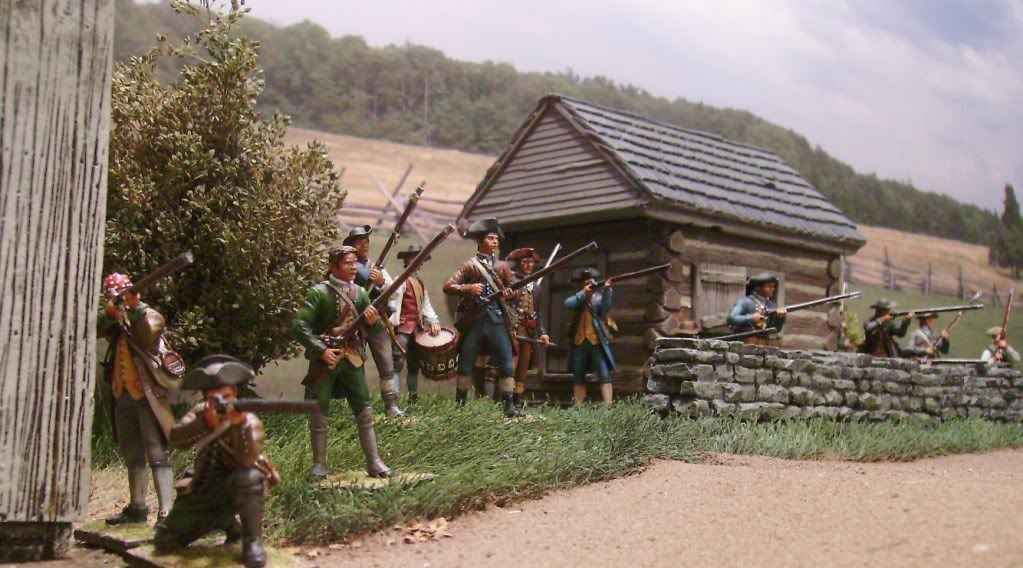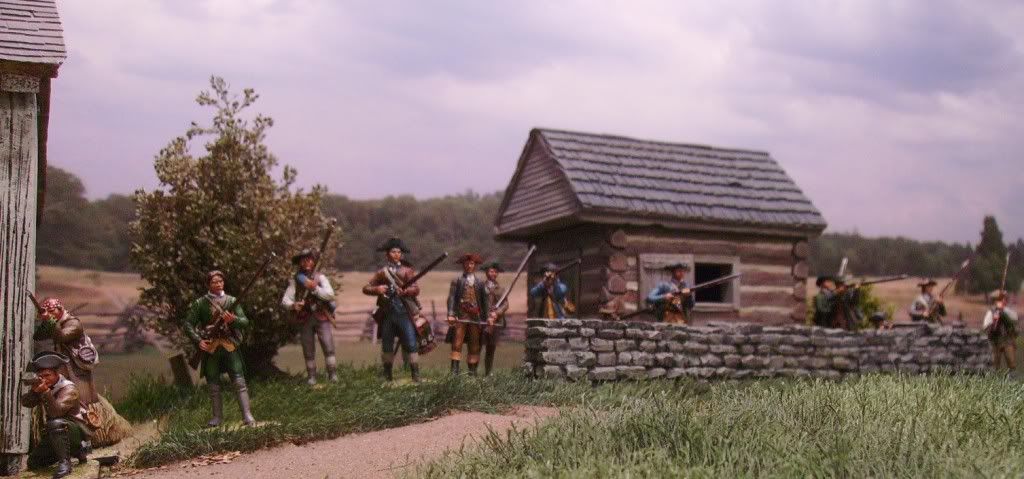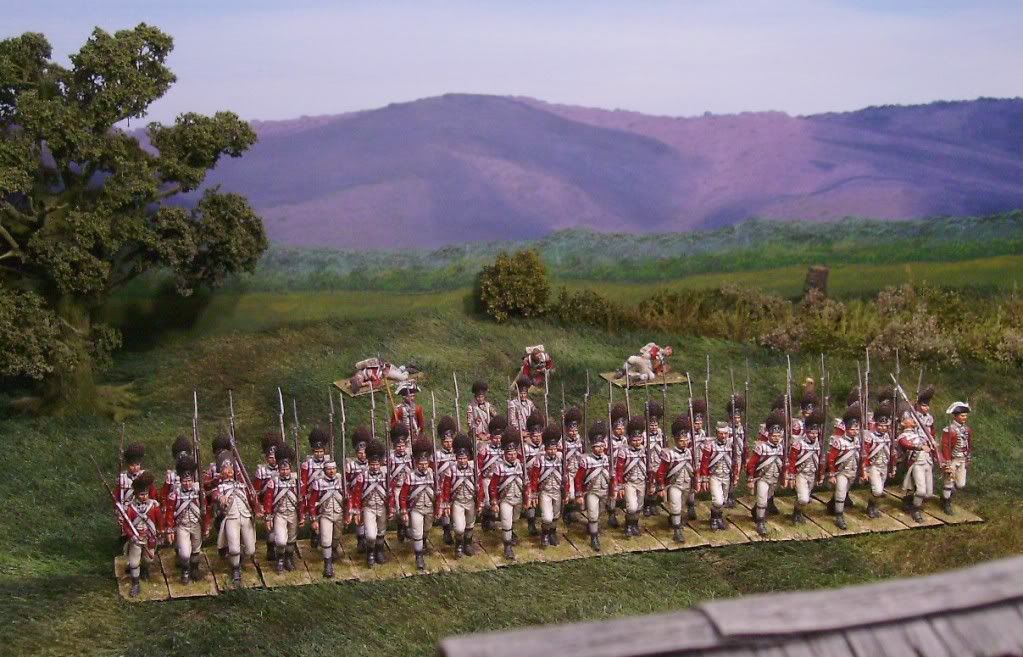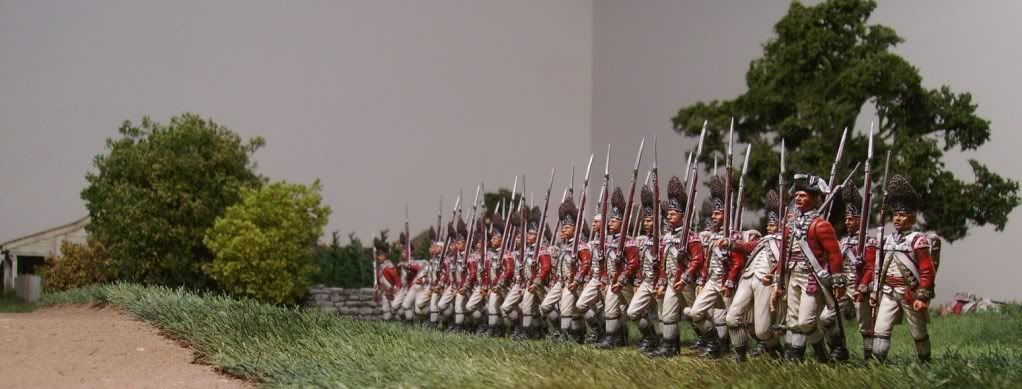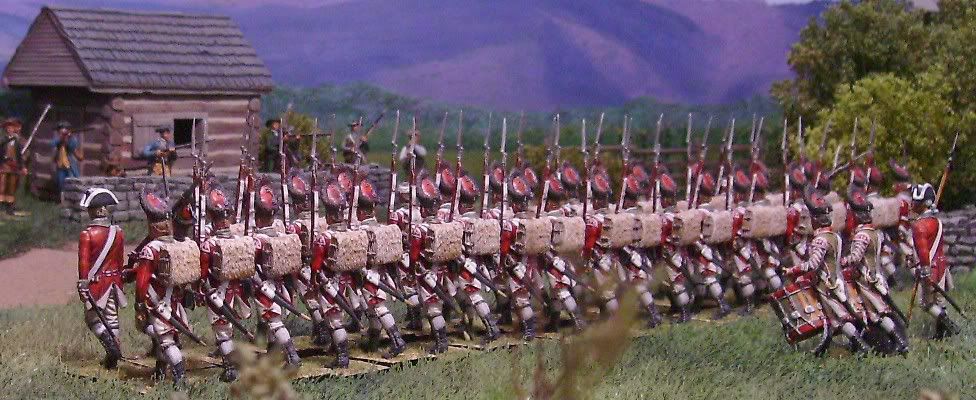Fusilier
Master Sergeant
- Joined
- Jan 9, 2009
- Messages
- 1,214
I have been going through some sources and trying to determine the company strength of various regiments, when I can find specific numbers. I have included the regimental strengths and the corresponding company estimates from a number of different battles. All fractions are rounded down and I did not include any Guards formations. Where flank units are included (or not), I note that.
The Battle of Saratoga saw the following British Regiments involved, with their regimental strength listed, as of July 1st, 1777: 9th (542), 20th (528), 21st (538), 24th (528), 47th (524), 53rd (537), and the 62nd (541). Divide each of these regimental strengths by 10 and you get the following approximate company estimates: 54, 52, 53, 52, 52, 53, 54. This makes an average of just over 52. Interesting to note that these regimental numbers are based on a full, 10-company regiment, as the grenadiers and light infantry were present with each of these regiments. Also, the flank companies of the following regiments were part of Burgoyne's Army: 29th, 31st, and 34th, with a combined strength of 329. Divide that number by 6 (3 regiments with two flank companies each) and you get a company strength of 54. Very consistent numbers. My source was John F. Luzader's book Saratoga: A Military History of the Decisive Campaign of the American Revolution.
The Battle of Monmouth saw the following British regiments involved, along with their strengths, as of June 28, 1778: 4th (321), 5th (367), 7th (333), 10th (135), 15th (352), 17th (330), 23rd (432), 26th (314), 27th (340), 28th (313), 33rd (365), 37th (386), 40th (322), 42nd in 2 battalions (639), 44th (334), 46th (319), 49th (372), 55th (268), 63rd (305), 64th (426). These regimental numbers do not include the flank companies, so the company strength estimates are: 32, 36, 33, 13, 35, 33, 43, 31, 34, 31, 36, 38, 32, 31, 33, 31, 37, 26, 30, 42. This makes an average of just under 33. Again, it is interesting to see the numbers are fairly consistent, even if significantly lower than the company strengths from Saratoga. I would attribute this to the weeks of marching and skirmishing prior to the Battle of Monmouth, whereas the number for Burgoyne's Army are from the first day of his campaign. Source for these numbers was Brendan Morrisey's title Monmouth Courthouse.
Anyone sick of numbers yet? Here is one more. The Battle of Cowpens and Guilford Courthouse was the following regiments, with their given strengths: Cowpens saw the 7th (175 in four consolidated companies) and 1st Battalion, 71st (263 probably 6 companies); Guilford Courthouse saw the 23rd (238 in 4 companies), 33rd (234 in 4 companies), 2nd Battalion, 71st (244 in 6 companies). There were no flank companies present with these regiments. These numbers show company strength estimates to be: 43, 43, 59, 58, and 40. This averages out to just under 49. Here it is interesting to see how the number of companies were reduced in order to keep company numbers higher, due partially to the long, drawn out campaigning these units had endured. Also, the severe shortage of officers helped necessitate this consolidation. Sources for these numbers were two superb books by Lawrence Babits: A Devil of a Whipping: The Battle of Cowpens and Long, Obstinate and Bloody: The Battle of Guilford Courthouse.
Here is one more. The Battle of Cowpens and Guilford Courthouse was the following regiments, with their given strengths: Cowpens saw the 7th (175 in four consolidated companies) and 1st Battalion, 71st (263 probably 6 companies); Guilford Courthouse saw the 23rd (238 in 4 companies), 33rd (234 in 4 companies), 2nd Battalion, 71st (244 in 6 companies). There were no flank companies present with these regiments. These numbers show company strength estimates to be: 43, 43, 59, 58, and 40. This averages out to just under 49. Here it is interesting to see how the number of companies were reduced in order to keep company numbers higher, due partially to the long, drawn out campaigning these units had endured. Also, the severe shortage of officers helped necessitate this consolidation. Sources for these numbers were two superb books by Lawrence Babits: A Devil of a Whipping: The Battle of Cowpens and Long, Obstinate and Bloody: The Battle of Guilford Courthouse.
Fascinating stuff, if you want to sift through the numbers. In the end, we see a consistent company strength well below the authorized number. While this is not news to anyone, it does show how the number was kept fairly consistent across the different regiments.
Noah
The Battle of Saratoga saw the following British Regiments involved, with their regimental strength listed, as of July 1st, 1777: 9th (542), 20th (528), 21st (538), 24th (528), 47th (524), 53rd (537), and the 62nd (541). Divide each of these regimental strengths by 10 and you get the following approximate company estimates: 54, 52, 53, 52, 52, 53, 54. This makes an average of just over 52. Interesting to note that these regimental numbers are based on a full, 10-company regiment, as the grenadiers and light infantry were present with each of these regiments. Also, the flank companies of the following regiments were part of Burgoyne's Army: 29th, 31st, and 34th, with a combined strength of 329. Divide that number by 6 (3 regiments with two flank companies each) and you get a company strength of 54. Very consistent numbers. My source was John F. Luzader's book Saratoga: A Military History of the Decisive Campaign of the American Revolution.
The Battle of Monmouth saw the following British regiments involved, along with their strengths, as of June 28, 1778: 4th (321), 5th (367), 7th (333), 10th (135), 15th (352), 17th (330), 23rd (432), 26th (314), 27th (340), 28th (313), 33rd (365), 37th (386), 40th (322), 42nd in 2 battalions (639), 44th (334), 46th (319), 49th (372), 55th (268), 63rd (305), 64th (426). These regimental numbers do not include the flank companies, so the company strength estimates are: 32, 36, 33, 13, 35, 33, 43, 31, 34, 31, 36, 38, 32, 31, 33, 31, 37, 26, 30, 42. This makes an average of just under 33. Again, it is interesting to see the numbers are fairly consistent, even if significantly lower than the company strengths from Saratoga. I would attribute this to the weeks of marching and skirmishing prior to the Battle of Monmouth, whereas the number for Burgoyne's Army are from the first day of his campaign. Source for these numbers was Brendan Morrisey's title Monmouth Courthouse.
Anyone sick of numbers yet?
Fascinating stuff, if you want to sift through the numbers. In the end, we see a consistent company strength well below the authorized number. While this is not news to anyone, it does show how the number was kept fairly consistent across the different regiments.
Noah


